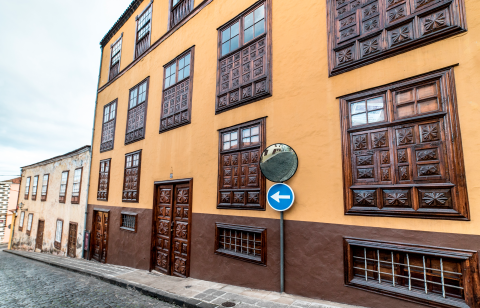
The stately buildings on Calle Tomás Zerolo were built surrounding the ravine, the town's main source of natural wealth. The street is characterised by its steepness. Architectural features that span from the 16th to 19th centuries can be found on the buildings along this street. The cobblestones, however, date from the early 20th century and were part of La Orotava's urban redevelopment during its trading heyday.
Traditional Canarian-style houses dominate the street, but two have Mudejar-style features: the Prieto Mendoza house, at number 22, and the Benítez de Lugo house further down, at number 19. The Mudejar architectural style dominated the Christian kingdoms of the Iberian Peninsula between the 12th and 16th centuries. It’s easily recognisable by its decorative features, which are mainly geometric. In the Canary Islands, Mudejar features can also be found from later centuries. At the Prieto Mendoza house, which was built at the end of the 18th century, you’ll find these features mainly in the woodwork on the doors and windows.
The Machado y Benítez de Lugo house at number 19, which dates from the 17th century, is also adorned with Mudejar features. Felipe Machado Benítez de Lugo, one of La Orotava's most distinguished figures from the second half of the 19th century, lived in this house.
A successful agricultural entrepreneur, politician, musician and artist, he is mainly known for his contribution to flower carpet making. Ever since the mid-twentieth century, flower carpets celebrating the feast of Corpus Christi have been made in La Orotava. This tradition has become one of the town’s main attractions and distinguishing features.
Felipe Machado Benítez de Lugo began his agricultural entrepreneurship with the production of cochineal, a natural dye made from insects. Cochineal fell into decline at the end of the 19th century as the use of chemical dyes spread. He later foresaw the profitability of the banana trade, becoming one of the promoters of this crop which would ultimately transform the landscape of the Canary Islands.
He was also one of the main supporters of the island's unified management model, known as "Cabildo Insular", and became vice-president of the island.
Let's continue down the street until reaching Santo Domingo Church.



